List of Washington state symbols
The U.S. state of Washington has 21 official emblems, as designated by the Washington State Legislature. These symbols, which reflect the history and culture of the state, are often opportunities for politicians to "tie themselves to popular symbols", for teachers to highlight the legislative process to their students, and for lobbyists to "have their products given official designation".[1]

While some of the symbols are unique to Washington, others are used by multiple states. For example, the willow goldfinch (also known as the American goldfinch), Washington's state bird, is also an official symbol for Iowa and New Jersey.[2] Washington's state grass, bluebunch wheatgrass, is also a symbol for the state of Montana.[3] The square dance and apple are commonly used state dances and state foods, respectively. While most states have an official motto and nickname, Washington's motto ("Al-ki", meaning "by and by" in Chinook Jargon) and nickname ("The Evergreen State") have never been officially adopted by the Legislature.[4]
Washington's first official symbol was its flag, adopted in 1923. While some symbols, including the state flower and state seal, were selected before then, they were not adopted by the Legislature until later. Washington's second symbol was western hemlock, selected as the state tree in 1947. Fourteen symbols were added between 1950 and 2000. Five symbols have been adopted in the 21st century. The newest symbol of Washington is state dinosaur, "Suciasaurus rex", which was declared in 2023.
Insignia
| Type | Symbol | Description | Adopted | Image |
|---|---|---|---|---|
| Flag | Flag of Washington | The Legislature adopted the state flag in 1923, more than thirty years after the state was admitted to the United States. By law (RCW 1.20.010), the flag "shall be of dark green silk or bunting and shall bear in its center a reproduction of the seal of the state of Washington embroidered, printed, painted or stamped thereon. The edges of the flag may, or may not, be fringed. If a fringe is used the same shall be of gold or yellow color of the same shade as the seal. The dimensions of the flag may vary."[5] | 1923 |  |
| Seal | Seal of Washington | Originally designed by Charles Talcott shortly before Washington was admitted to the United States in 1889, the seal contains the image of George Washington encircled with "The Seal of the State of Washington" and the date "1889". The simple design was accepted by the Legislature, but did not become the official seal until graphic designer Richard Nelms was commissioned to create a new insignia. Nelms used a portrait by painter Gilbert Stuart in his design, which was accepted by the Legislature in 1967.[6] | 1967 | 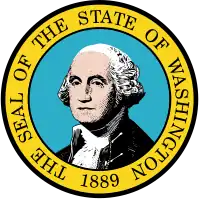 |
Species
| Type | Symbol | Description | Adopted | Image |
|---|---|---|---|---|
| Amphibian | Pacific chorus frog (Pseudacris regilla) |
Native to the Pacific Northwest, the Pacific Chorus Frog was designated as the state amphibian because it lives on both sides of the Cascade Range and within each county of the state. The symbol was proposed by third graders at Boston Harbor Grade School in north Olympia. | 2007 | 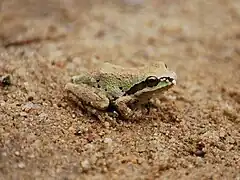 |
| Bird | American goldfinch (Spinus tristis) |
In 1928, school children selected the meadowlark as the state bird, the same choice made by seven other states at the time. The Washington Federation of Women's Clubs picked the goldfinch as the state symbol in 1931 over the tanager, song sparrow, junco and pileated woodpecker. Two decades later, legislators allowed school children to decide between the two birds, and the goldfinch was chosen. | 1951 |  |
| Dinosaur | "Suciasaurus rex" | The specimen, the state's first dinosaur fossil, was of a theropod discovered in 2012 and selected as a state symbol based on the advocacy of school students.[7] | 2023 | 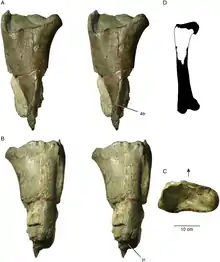 Femur of "Suciasaurus rex" |
| Endemic mammal | Olympic marmot (Marmota olympus) |
One of the only endemic mammals in Washington, the highly social Olympic marmot can be found throughout the Olympic Peninsula and are easy to spot during the summer months along Hurricane Ridge in Olympic National Park. To promote awareness of the animal, the Legislature adopted the state endemic mammal in 2009. | 2009 | 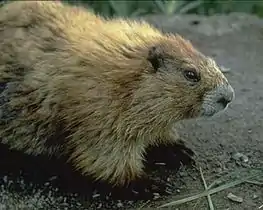 |
| Fish | Steelhead trout (Oncorhynchus mykiss) |
Adopted as the state fish in 1969, the steelhead is one of the most popular fish for recreational fishing in Washington. While the Legislature used an old scientific name Salmo gairdnerii to describe the fish,[8] two subspecies of rainbow trout are anadromous and known as steelhead—Columbia River redband trout O. m. gairdneri and coastal rainbow trout O. m. irideus.[9] | 1969 | |
| Flower | Pacific rhododendron (Rhododendron macrophyllum) |
Before suffrage, Washington women selected the coast rhododendron as the state flower in 1892. Six flowers were initially considered as an entry for a floral exhibit at the 1893 World's Columbian Exposition, but the rhododendron beat out the clover following a statewide election. In 1959, the lawmakers officially designated the native species Rhododendron macrophyllum as the state flower. | 1959 |  |
| Fruit | Apple (Malus domestica) |
In 1989, Rep. Clyde Ballard proposed a bill that would designate the apple as Washington's state fruit and require that they appear on new license plates.[10] The apple trees of Eastern Washington represent one of the state's largest industries and led the nation in apple production. | 1989 | 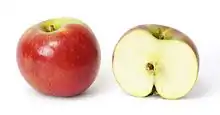 |
| Grass | Bluebunch wheatgrass (Agropyron spicatum) |
Native to Eastern Washington, bluebunch wheatgrass supports the cattle and livestock industry and was designated as the state grass in 1989. | 1989 | 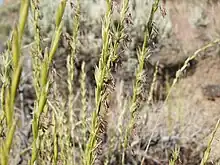 |
| Insect | Green darner dragonfly (Anax junius) |
The common green darner dragonfly was designated as the state insect in 1997 following a proposal by students at Crestwood Elementary School in Kent and the support of children in more than 100 school districts statewide. This dragonfly species can be found throughout Washington and is a "beneficial contributor to the ecosystem because it consumes a large number of insect pests."[11] | 1997 |  |
| Marine mammal | Orca (Orcinus orca) |
Following a proposal submitted by students at Crescent Harbor Elementary in Oak Harbor, the Legislature adopted the orca as the state marine mammal in 2005 since it attracts many tourists, is a significant symbol for the Native American culture, and pods of the whales migrate through Puget Sound each year. The designation is also intended to promote awareness of the whale and encourage protection of the marine environment. | 2005 |  |
| Oyster | Olympia oyster (Ostrea lurida) |
The Olympia oyster is the only oyster native to Washington.[12] | 2014 | 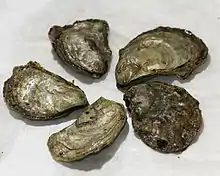 |
| Tree | Western hemlock (Tsuga heterophylla) |
In 1946, The Portland Oregonian teased Washington for not having a state tree, suggesting the western hemlock for its neighbor. Washington newspapers preferred the popular western red cedar, but state representative George Adams insisted on the western hemlock, claiming the species would become "the backbone of [the] state's forest industry".[11] Adams' bill passed the Legislature and became law in 1947. | 1947 | 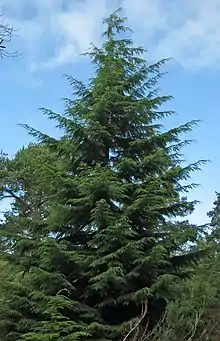 |
| Vegetable | Walla Walla sweet onion (Allium cepa) |
Originally from the island of Corsica, a sweet onion seed was brought to Walla Walla by a French soldier more than a century ago. Well-suited for the climate offered by southeastern Washington, many Walla Walla Valley farmers continue to grow the onions today. The onion was designated as the state vegetable due to the persistence of students at Eatonville Middle School and Kirkland Junior High School.[13] | 2007 | 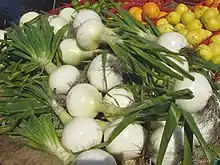 |
Geology
| Type | Symbol | Description | Adopted | Image |
|---|---|---|---|---|
| Fossil | Columbian mammoth (Mammuthus columbi) |
The Legislature designated the Columbian mammoth as the state fossil in 1998, following a four-year effort by students at Windsor Elementary School near Cheney. During the Pleistocene, the prehistoric elephants roamed throughout the United States, including the Pacific Northwest. These fossils were discovered on the Olympic Peninsula. | 1998 | 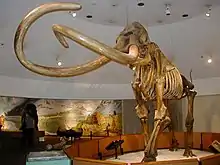 |
| Gem | Petrified wood | Petrified wood, formed when water permeates wood and replaces the fiber with silica, can be found in almost every county of the state in a variety of tree species, "some extinct and some exquisite".[14] Petrified wood was discovered in Vantage in the early 1930s, which led to the creation of the Ginkgo Petrified Forest State Park as a national historic preserve.[15] Other sites with petrified wood include the Umtanum Petrified Forest and the Saddle Mountain Petrified Forest.[16] | 1975 |  |
| Waterfall | Palouse Falls | 198-foot waterfall created by ice age floods.[12] | 2014 |  |
Culture
| Type | Symbol | Description | Adopted | Image |
|---|---|---|---|---|
| Arboretum | Washington Park Arboretum | Managed by Seattle and the University of Washington, the arboretum is a "living museum" that encourages conservation and displays plants from around the world that can grow in the Pacific Northwest.[12] The arboretum is the "oldest center for botanical and gardening learning" in the region, and is recognized as one of the two foremost collections of woody plants in the country. | 1995 | 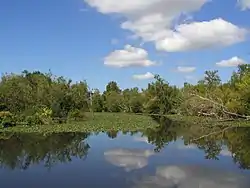 |
| Dance | Square dance | When pioneers migrated west, they brought with them a dance known as the quadrille. A folk dance with four couples (eight dancers) arranged in a square, the square dance became the state dance on April 17, 1979. | 1979 | 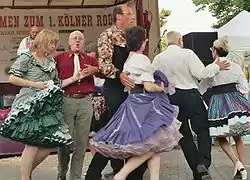 |
| Folk song | "Roll On, Columbia, Roll On" | The Bonneville Power Administration produced a film in the 1940s encouraging Pacific Northwest residents to use power generated by the recently built Bonneville and Grand Coulee dams along the Columbia River. Folk musician Woody Guthrie was hired to write songs for the project; "Roll On, Columbia, Roll On", described as "an ode to the harnessing of Washington's mightiest river", was the most popular of the 26 songs. In 1987, the song was officially designated as the state folk song by the Legislature. | 1987 |  |
| Ship | Lady Washington | Lady Washington is the name for the original wooden merchant sailing vessel that sailed during the 18th century as well as the updated modern replica created in 1989. Named after Martha Washington, the original ship left Boston Harbor on October 1, 1787 as part of the Columbia Expedition and foundered in 1797. The replica was built in Aberdeen as part of the state centennial celebrations of 1989.[17] | 2007 |  |
| Song | "Washington, My Home" | Written by Helen Davis in 1950[18] and arranged by Stuart Churchill, "Washington, My Home" was approved unanimously after a State Senator from South Bend introduced a bill proposing the song as the state song. In 1909, "Washington Beloved" was unofficially adopted as the state song but was never part of the state's code of law. | 1959 | — |
| Sport | Pickleball | A racket/paddle sport invented by several families on a modified badminton court in Bainbridge Island in 1965. It was approved as the state sport in 2022 following lobbying from the sport's national association.[19] | 2022 | 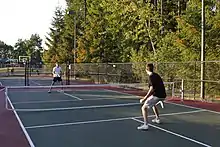 |
| Tartan | Washington state tartan | Consisting of a green background with stripes of blue, white, yellow, red, and black, the state tartan of Washington was designed by Margaret McLeod van Nus and Frank Cannonita in 1988 to commemorate the Washington centennial celebration and is registered with the Scottish Tartans Society. The colors represent various aspects of nature: green symbolizes rich forests of the state; blue the lakes, rivers and ocean; white the snow-capped mountains; red the apple and cherry crops; yellow the wheat and grain crops; and black the eruption of Mount St. Helens.[20] | 1991 | 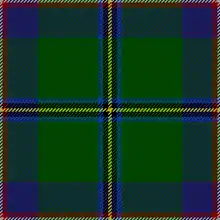 |
Unofficial symbols and unsuccessful proposals
While most states have an official motto and nickname, the Washington Legislature never officially adopted either. "Al-ki", meaning "by and by" in Chinook Jargon, is the state's unofficial motto, first appearing on the territorial seal designed by Lt. J.K. Duncan. Washington was unofficially nicknamed "The Evergreen State" by pioneer and historian C.T. Conover for its abundant evergreen forests.[4]
Several symbols have been proposed for addition to the list of official state symbols but were never adopted. Proposed symbols have included Richard Berry's "Louie Louie" as the state song[21] and Aplets and Cotlets (a confection made from apples and apricots by Liberty Orchards) as the state candy.[22] The designation of sasquatch as the state's official cryptid or monster has been proposed since the 1970s, going as far as a joke proclamation issued by Governor Daniel J. Evans in 1970.[23]
See also
References
- General
- "Chapter 1.20 RCW". Secretary of State of Washington. Archived from the original on February 12, 2006. Retrieved December 19, 2009.
- "State Symbols". Secretary of State of Washington. Archived from the original on March 14, 2017. Retrieved December 14, 2009.
- Johns, Linda (2004). Uniquely Washington. Reed Elsevier. pp. 12–16. ISBN 978-1-4034-4513-1. Archived from the original on December 26, 2021. Retrieved December 19, 2009.
- "About Washington" Archived September 18, 2020, at the Wayback Machine HistoryLink
- Specific
- James, Michael S. (December 27, 2004). "State Pride, Via Soil, Milk, Popcorn, Pork". ABC News. Archived from the original on June 4, 2011. Retrieved January 12, 2010.
- Hinterberger, John (August 19, 1973). "Cries of 'Fowl' echo in state". The Seattle Times. p. B8.
- "Symbols of Montana". Montana Historical Society. Archived from the original on December 18, 2009. Retrieved December 17, 2009.
- "State Symbols". Washington State Legislature. Archived from the original on January 5, 2019. Retrieved December 21, 2009.
- "History of the State Flag". Secretary of State of Washington. Archived from the original on November 19, 2009. Retrieved December 14, 2009.
- "History of the State Seal". Secretary of State of Washington. Archived from the original on January 8, 2010. Retrieved December 20, 2009.
- "Suciasaurus rex becomes official Washington state dinosaur after Gov. Inslee signs bill", KING-TV, May 5, 2023. Accessed May 8, 2023. "Washington officially has its first state dinosaur. Gov. Jay Inslee signed House Bill 1020 on Thursday, which designates the Suciasaurus rex as the official dinosaur of the state of Washington. Following the bill signing, Inslee recognized eighth-grader Athena Tauscher as 'Washingtonian of the Day' for her work on the bill.... The dinosaur represents the first dinosaur fossil ever found in Washington state by paleontologists back in 2012. The fossil belonged to a therapod, a two-legged meat eater like the Velociraptor and the Tyrannosaurus rex, according to the Burke Museum."
- "Symbols of Washington State" (PDF). Washington State Legislature. Archived (PDF) from the original on October 29, 2013. Retrieved March 4, 2014.
- Behnke, Robert J.; Tomelleri, Joseph R. (illustrator) (2002). "Rainbow and Redband Trout". Trout and Salmon of North America. New York: The Free Press. pp. 65–120. ISBN 0-7432-2220-2.
- "Bill would make apple state fruit". Spokane Chronicle. Cowles Publishing Company. January 6, 1989. Archived from the original on December 26, 2021. Retrieved December 18, 2009.
- "State Symbols". Secretary of State of Washington. Archived from the original on December 10, 2009. Retrieved December 14, 2009.
- "Chapter 1.20 RCW". Secretary of State of Washington. Archived from the original on February 12, 2006. Retrieved December 19, 2009.
- Tuinstra, Rachel (February 15, 2006). "Students taste sweet victory as onion passes first hurdle to state icon status". The Seattle Times. The Seattle Times Company. Archived from the original on January 9, 2016. Retrieved December 21, 2009.
- Johnston, Greg (June 26, 1997). "Rocks of Ages: Washington is a gem of a state for amateur geologists". Seattle Post-Intelligencer. Hearst Corporation. Archived from the original on February 8, 2002. Retrieved January 12, 2018.
- "Ginkgo Petrified Forest/Wanapum Recreational Area". Washington State Parks and Recreation Commission. Archived from the original on December 18, 2009. Retrieved December 19, 2009.
- Mapes, Lynda V. (May 4, 2007). "Rare surprise for Yakima man: a forest of stone". The Seattle Times. The Seattle Times Company. Archived from the original on January 13, 2018. Retrieved January 13, 2018. Note: Sites are mentioned under the "Petrified-wood facts" column, which cites the Washington State Department of Natural Resources.
- "The Historical Seaport: Lady Washington". Grays Harbor Historical Seaport Authority. Archived from the original on April 7, 2010. Retrieved December 21, 2009.
- Whitely, Peyton (January 2, 1993). "Helen Davis, who wrote state song and was matriarch of South Bend". The Seattle Times. p. C12. Archived from the original on January 13, 2018. Retrieved January 12, 2018.
- Zhou, Amanda (March 28, 2022). "Pickleball officially named WA state sport". The Seattle Times. Retrieved March 28, 2022.
- "State Symbols". leg.wa.gov. Archived from the original on February 20, 2021. Retrieved February 21, 2021.
- Stout, Gene (June 22, 2000). "'Louie Louie': The dope on the unintelligible classic". Seattle Post-Intelligencer. Hearst Corporation. Archived from the original on June 7, 2002. Retrieved January 12, 2018.
- "Washington Legislature will mull naming state candy". Puget Sound Business Journal. American City Business Journals. December 30, 2008. Archived from the original on June 4, 2011. Retrieved January 19, 2010.
- "History Friday: Washington's Official State Monster". Washington Secretary of State. January 12, 2018. Archived from the original on January 13, 2018. Retrieved January 12, 2018.
External links
 Media related to Symbols of Washington (state) at Wikimedia Commons
Media related to Symbols of Washington (state) at Wikimedia Commons